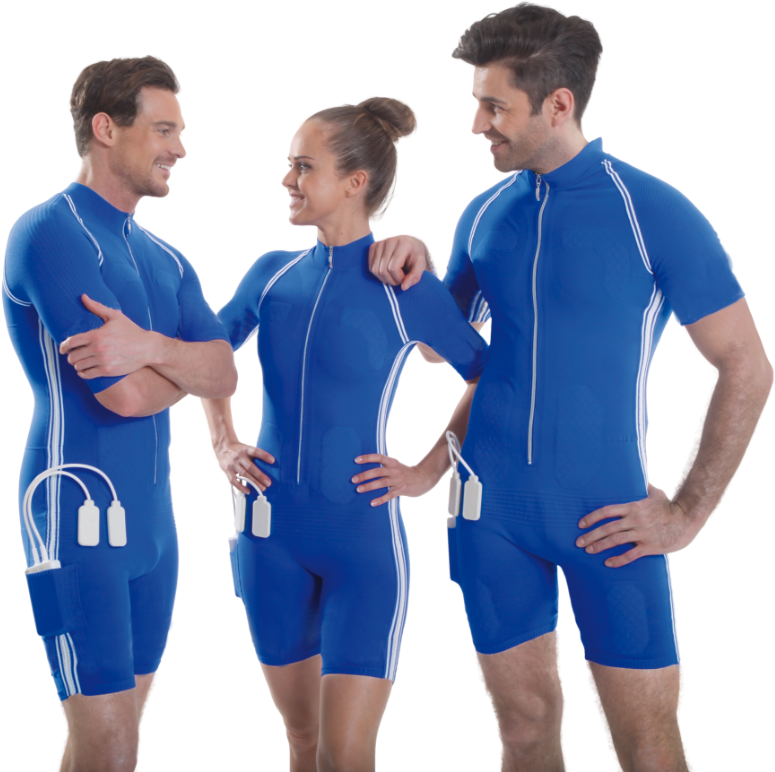Sprint and jump
- The sprint studies showed improvements in competitive athletes of 3.1±1.7% over a 3-week period.
- Brocherie et al. (2) improvement of 4.8% in the sprint time of ice hockey players over 10m.
- Pichon et al. (9) improvement of 1.3% to cover 25m (sport type: swimming) and 1.45% for the 50m freestyle time.
- With combined strength training (plyometrics/EMS), Herrero et al. recorded (3) a 2.3% reduction in time needed to spring 20m among untrained individuals.
- After EMS training, jumping abilities improved by between 2.3% and 19.2%; after isometric EMS training (an average of +10±6.5%); and 6.7% to 21.4% after dynamic EMS training (1, 4, 5, 7, 8, 13).
- After combined EMS training, the literature states that there was an average increase in jumping ability of 11.2±5.5% (3, 6, 11).
Selected Literature:
- Babault, N., Cometti, G., Bernardin, M., Pousson, M. &Chatard, J.-C. (2007). Effects of Electromyostimulation Training on Muscle Strength and Power of Elite Rugby Players. Journal of Strength and Conditioning Research, 21(2), 431-437.
- Brocherie, F., Babault, N., Cometti, G., Maffiuletti, N., & Chatard, J. C. (2005). Electrostimulation training effects on the physical performance of ice hockey players. Med Sci Sports Exerc, 37(3), 455-460.
- Herrero, J. A., Izquierdo, M., Maffiuletti, N. A., & Garcia-Lopez, J. (2006). Electromyostimulation and plyometric training effects on jumping and sprint time. Int J Sports Med,27(7), 533-539.
- Kots, J.M. & Chwilon, W. (1971). Das Muskelkrafttrainingmit der Methode der Elektromyostimulation (russ.). In: Adrianowa, G. et al. (1974). Die Anwendung derElektrostimulation für das Training der Muskelkraft.
- Maffiuletti, N. A., Cometti, G., Amiridis, I. G., Martin, A., Pousson, M., & Chatard, J. C. (2000). The effects of electromyostimulation training and basketball practice on muscle strength and jumping ability. Int J Sports Med, 21(6), 437-443.
- Maffiuletti, N. A., Dugnani, S., Folz, M., Di Pierno, E., & Mauro, F. (2002a). Effect of combined electrostimulation and plyometric training on vertical jump height. Med Sci Sports Exerc, 34(10), 1638-1644.
- Malatesta, D., Cattaneo, F., Dugnani, S., & Maffiuletti, N. A. (2003). Effects of electromyostimulation training and volleyball practice on jumping ability. J Strength Cond Res, 17 (3), 573-579.
- Paillard, T. (2008). Combined Application of Neuromuskular Electrical Stimulation and Voluntary Muscular Contractions. Sports Med, 38 (2), 161-177.
- Pichon, F., Chatard, J. C., Martin, A., & Cometti, G. (1995). Electrical stimulation and swimming performance. Med Sci Sports Exerc, 27(12), 1671-1676.
- Ronnestad, B.R., Kvamme, N.H., Sunde, A., & Raastad, T. (2008). Short-Term Effects of Strength and Plyometric Training on Sprint and Jump Performance in Professional Soccer Players. Journal of Strength and Conditioning Research, 22(3), 733-780.
- Venable, M.P., Collins, M.A., O´Brynt, H.S., Denegar, C.R., Sedivec, M.J., & Alon, G. (1991). Effects of Supplemental Electrical Stimulation on the Development of Strength, Vertical Jump Performance and Power. Journal of Applied Sport Science Research, 5 (3), 139-143.
- Willoughby, D.S., & Simpson, S. (1996). The Effects of Combined Electromyostimulation and Dynamic Muscular Contractions on the Strength of College Basketball Players. Strength and Cond. Res., 10(1), 40-44.
- Willoughby, D.S., & Simpson, S. (1998). Supplemental EMS and Dynamic Weight Training: Effects on Knee Extensor Strength and Vertical Jump of Female College Track & Field Athletes. Strength and Cond. Res., 12 (3), 131-137.
- Wissloff, U., Castagna, C. Helgerud, J. Jones, R., & Hoff, J. (2004). Strong correlation of maximal squat strength with sprint performance and vertical jump height in elite soccer players. Br. J. Sports Med, 38, 285-288
Related Knowledge Base Posts -
- Elasticity and performance
- Stamina
- Maximal oxygen consumption at the anaerobic threshold

